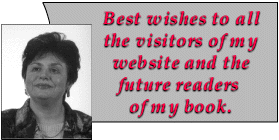The author, Regina Shmelkina, is a clinical neurophysiologist and Doctor of Science from Ukraine. She has more than twenty-year experience in clinical EEG diagnostics and research. She is a member of ACNS.
Dr. Shmelkina has published several articles in professional journals, such as “Neurology and Physiology,” “Human Physiology,” and “Sports Psychology” in the former Soviet Union.
She is continuing her research in the U.S. Dr. Shmelkina issued two monographs regarding space-occupying processes and EEG reactivity (to see praise for these monographs, please click here).Her articles appeared in the U.S. publications “Applied Psychophysiology and Biofeedback,” Vol. 23, Num. 2 (June 1998) and Vol. 24, Num. 2 (June 1999).
On this website, research data in the field of electroencephalography and other fields related to clinical neurology (self-regulation and biofeedback) are presented. Some of these data were published earlier and some have only been obtained of late. These data have great significance for diagnosis and treatment.
E-mail: rsh712230@gmail.com
Published Works
Material presented here is taken from monographs published by Regina Shmelkina |
ELECTROENCEPHALOGRAPHY AND LOCAL PATHOLOGICAL BRAIN PROCESSES. ATLAS. REGINA D. SHMELKINA Copyright © 1997 by Regina D. Shmelkina First Edition. All rights reserved. Abstract* |
*The entire book is composed of 138 pages. |
|
This book is dedicated to my father and teacher David Shmelkin (1898-1978), Professor of Neurology and pioneer of clinical EEG in the former Soviet Union. |
To order the book “ELECTROENCEPHALOGRAPHY AND LOCAL PATHOLOGICAL BRAIN PROCESSES. ATLAS,” please see- Contact Information
“SOME FINDINGS OF BRAIN REACTIVITY ACCORDING TO EEG DATA UNDER INFLUENCE
OF STIMULI IN CONNECTION WITH AGE.”
REGINA SHMELKINA
Copyright © 1998 by Regina D. Shmelkina. All rights reserved.
Abstract
Summary |
1. Our research has demonstrated that in response to eye opening, all individuals have adequate level of suppression of alpha-rhythm. In group I (children) and in group III (the elderly) there appeared to be a lower level of alpha-suppression. More markedly, alpha-attenuation was expressed in group II (adults of 18-35 years old). The failure of alpha-alteration is probably associated with the fact that mechanism of alpha blocking desynchronizing system has not matured functionally and morphologically in children, and in the elderly, it is weakened. 2. We observed the reaction of alpha-rhythm in response to various differential stimuli (visual, auditory, tactile, and smell). In most cases, we revealed the suppression of alpha-rhythm. It was most pronounced in response to visual stimuli. 3. The imaging of various afferently stimuli in wakefulness by healthy people, when people experience distinct feelings, causes alpha-rhythm suppression more marked in the left hemisphere. It is more pronounced in response to visual stimuli than to other modalities. 4. Studies have shown that hyperventilation with combination of eye-opening causes the failure of attenuation of alpha-rhythm in the same way as alpha-index. So, alpha-amplitude in all age groups was more pronounced, but stronger in children. We suppose that it may be associated with greater sensitivity of children to hyperventilation. 5. There is some more parallelism between alpha-suppression in response to eye opening and alpha-suppression to visual imaging: if the reactivity to eye opening is poor, the reactivity to visual imaging is also bad, and vice versa. 6. After hyperventilation during visual imaging, the significant worsening of alpha-reactivity appears in 81.2 % of the cases. 7. In the first seconds after eye closure, approximately 20% of healthy people (in 52 % of the elderly) we noticed the decreasing of alpha-rhythm “exhausting,” that is further fading by amplitude and index (the so-called “exhausting” of alpha”). It could be explained because of failure of alpha-generating mechanisms. 8. After influence of hyperventilation, the “exhausting” of alpha-rhythm after eye closure is significantly worsened (it remains only in 13.3 % of cases in the elderly) or disappears at all in healthy people. 9. After hyperventilation, paroxysmal activity is expressed less in athletes. 10. In most neurotic patients, the “exhausting” of alpha is noticed after hyperventilation and eye closure. 11. The obtained data can be of significance for the determination of the criteria of normal brain activity in EEG. |
News & Articles
“Some EEG Findings Caused by Different Imaging Stimuli” |
Regina Shmelkina |
Applied Psychophysiology and Biofeedback |
Volume 23, Number 2, June 1998 |
“Some EEG Findings Caused by Real and Imaginary Stimuli in Patients and Healthy Subjects” |
Regina Shmelkina |
Applied Psychophysiology and Biofeedback |
Volume 24, Number 2, June 1999 |
